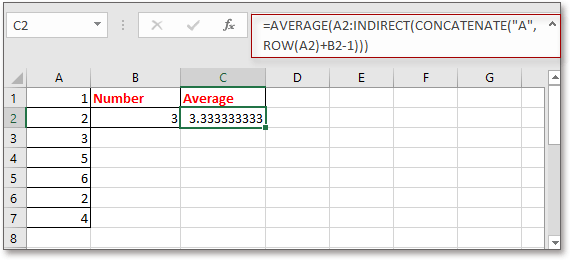如何在Excel中基於另一個單元格值定義範圍?
對於大多數Excel用戶而言,計算值範圍很容易,但是您是否曾經嘗試過根據特定單元格中的數字來計算值範圍? 例如,A列中有一列值,我想根據B2中的值計算A列中的值數,這意味著如果B4中為2,我將對B4中的前XNUMX個值求平均值A欄,如下圖所示。 現在,我介紹一個簡單的公式,以基於Excel中的另一個單元格值快速定義範圍。
 根據單元格值定義範圍
根據單元格值定義範圍
要基於另一個單元格值對范圍進行計算,可以使用一個簡單的公式。
選擇要輸出結果的空白單元格,輸入此公式 =平均(A1:INDIRECT(CONCATENATE(“ A”,B2))),然後按 Enter 獲得結果的關鍵。
1.在公式中,A1是要計算的列中的第一個單元格,A是要計算的列,B2是要基於其計算的單元格。 您可以根據需要更改這些引用。
2.如果要進行匯總,則可以使用此公式 = SUM(A1:INDIRECT(CONCATENATE(“ A”,B2))).
3.如果要定義的第一個數據不在Excel的第一行中,例如在單元格A2中,則可以使用以下公式: =平均(A2:INDIRECT(CONCATENATE(“ A”,ROW(A2)+ B2-1))).
在Excel中按背景或格式顏色快速計數/求和單元格 |
| 在某些情況下,您可能具有多種顏色的單元格範圍,而您想要的是基於相同顏色對值進行計數/求和,那麼如何快速計算? 這款獨特的敏感免洗唇膜採用 Moisture WrapTM 技術和 Berry Mix ComplexTM 成分, Excel的Kutools's 按顏色計數,您可以按顏色快速進行許多計算,還可以生成計算結果的報告。 點擊即可獲得 30 天的免費全功能試用! |
 |
| Kutools for Excel:擁有300多個便捷的Excel加載項,可以在30天內免費試用。 |
最佳辦公生產力工具
| 🤖 | Kutools 人工智慧助手:基於以下內容徹底改變數據分析: 智慧執行 | 生成代碼 | 建立自訂公式 | 分析數據並產生圖表 | 呼叫 Kutools 函數... |
| 熱門特色: 尋找、突出顯示或識別重複項 | 刪除空白行 | 合併列或儲存格而不遺失數據 | 沒有公式的回合 ... | |
| 超級查詢: 多條件VLookup | 多值VLookup | 跨多個工作表的 VLookup | 模糊查詢 .... | |
| 高級下拉列表: 快速建立下拉列表 | 依賴下拉列表 | 多選下拉列表 .... | |
| 欄目經理: 新增特定數量的列 | 移動列 | 切換隱藏列的可見性狀態 | 比較範圍和列 ... | |
| 特色功能: 網格焦點 | 設計圖 | 大方程式酒吧 | 工作簿和工作表管理器 | 資源庫 (自動文字) | 日期選擇器 | 合併工作表 | 加密/解密單元格 | 按清單發送電子郵件 | 超級濾鏡 | 特殊過濾器 (過濾粗體/斜體/刪除線...)... | |
| 前 15 個工具集: 12 文本 工具 (添加文本, 刪除字符,...) | 50+ 圖表 類型 (甘特圖,...) | 40+ 實用 公式 (根據生日計算年齡,...) | 19 插入 工具 (插入二維碼, 從路徑插入圖片,...) | 12 轉化 工具 (數字到單詞, 貨幣兌換,...) | 7 合併與拆分 工具 (高級合併行, 分裂細胞,...) | ... 和更多 |
使用 Kutools for Excel 增強您的 Excel 技能,體驗前所未有的效率。 Kutools for Excel 提供了 300 多種進階功能來提高生產力並節省時間。 點擊此處獲取您最需要的功能...

Office選項卡為Office帶來了選項卡式界面,使您的工作更加輕鬆
- 在Word,Excel,PowerPoint中啟用選項卡式編輯和閱讀,發布者,Access,Visio和Project。
- 在同一窗口的新選項卡中而不是在新窗口中打開並創建多個文檔。
- 將您的工作效率提高 50%,每天為您減少數百次鼠標點擊!

Sort comments by
#39313
This comment was minimized by the moderator on the site
0
0
#37232
This comment was minimized by the moderator on the site
Report
0
0
#37233
This comment was minimized by the moderator on the site
Report
0
0
#37234
This comment was minimized by the moderator on the site
Report
0
0
#36355
This comment was minimized by the moderator on the site
0
0
#35952
This comment was minimized by the moderator on the site
0
0
#38115
This comment was minimized by the moderator on the site
0
0
#33415
This comment was minimized by the moderator on the site
0
0
#33260
This comment was minimized by the moderator on the site
0
0
#33261
This comment was minimized by the moderator on the site
Report
0
0
#33257
This comment was minimized by the moderator on the site
0
0
#33177
This comment was minimized by the moderator on the site
0
0
#33178
This comment was minimized by the moderator on the site
0
0
#38036
This comment was minimized by the moderator on the site
0
0
#38077
This comment was minimized by the moderator on the site
Report
0
0
#38081
This comment was minimized by the moderator on the site
0
0
#38133
This comment was minimized by the moderator on the site
Report
0
0
#31400
This comment was minimized by the moderator on the site
0
0
#31401
This comment was minimized by the moderator on the site
0
0
#19967
This comment was minimized by the moderator on the site
0
0
#19968
This comment was minimized by the moderator on the site
Report
0
0
There are no comments posted here yet